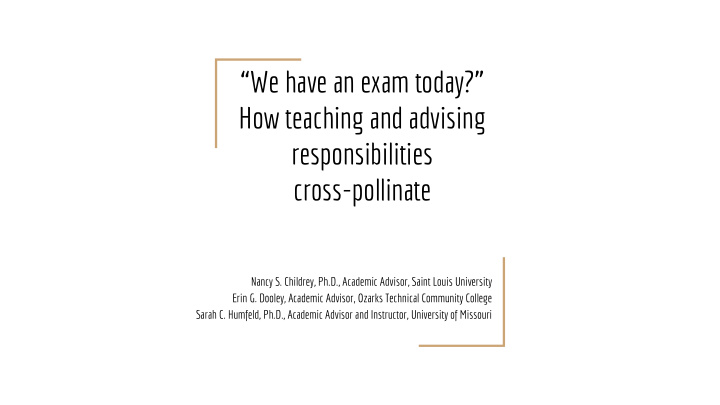



“We have an exam today?” How teaching and advising responsibilities cross-pollinate Nancy S. Childrey, Ph.D., Academic Advisor, Saint Louis University Erin G. Dooley, Academic Advisor, Ozarks Technical Community College Sarah C. Humfeld, Ph.D., Academic Advisor and Instructor, University of Missouri
Introductions Differences between our institutions ● How we came into teaching/advising roles ● Why we wanted to do a panel discussion ● What courses we are teaching ●
Nancy Childrey Institution: Saint Louis University Classes taught: ASCI 1010: Professional Orientation (online, non-traditional students) (4) ● ASCI 1510: The Air Transportation System (on-ground, ● freshmen/sophomore level students) (10) Advising effort/model: 260 students ● Mandatory advising each semester ●
Erin Dooley Institution: Ozarks Technical Community College Classes taught: CAC-101: Strengths in Careers and Beyond (30) ● Advising effort/model: 50-75 assigned advisees ● Blended Model, Walk-In Advisement Center ● Not mandatory for students with good academic standing ●
Sarah Humfeld Institution: University of Missouri Classes taught: NatR 1070 - Ecology and Renewable Resource Management (Intro) (70) ● F_W 3600 - Introduction to Conservation Biology (50) ● Advising effort/model: 75% FTE ● ~200 advisees ● Required each semester during early registration ●
Who is our audience? Tell us a little bit about yourself! Where do you work? ● In what role(s)? ● Why are you here today? ●
Overview Leveraging advising experience to inform the teaching practice ● and vice versa Identifying institutional support for teaching advisors ● Managing increased responsibilities ● Navigating dual relationships with students ●
How do you leverage your advising experience to inform the teaching practice and vice versa? Teaching informs advising ● Deeper understanding of classroom challenges ○ Advice regarding specific study methods ○ Advising informs teaching ● Greater emphasis on integrating meta-skills and career development ○ Vision of how classes across curriculum fit together ○ Know performance history of student; can see progress ○ Can write great letters of recommendation!
What institutional support is available for teaching advisors? Centers for Teaching and Learning available to all ● But divisions between faculty & staff - culture ○ Other training opportunities ● But timing conflicting with advising responsibilities ○ Access to Instructional Designers
How do you manage increased responsibilities? Advising models at our different institutions: Walk-in model ● Required advising each semester for majors ● Number of students in our classes (4-75) Daily priorities: Importance of protecting time ● How/if students schedule appointments ○ Office hours ○ Tasks across semester (how to teach during early ● registration period?)
How do you navigate dual relationships with students? Potential to recognize student progress over time ● Can be awkward: student performing poorly in class ● Can be synergistic: instructor knows student career/academic interests to ● focus course content Help troubleshoot issues in first year ● Are emails confusing to students? Course related or advising? ●
Wrapping Up Pros: Cons: Ability to get to know students Time ● ● at a different level Incompatible scheduling ● Ability to help students on a Complications of dual ● ● different level relationships with students Increased understanding of ● ● and connection with faculty ● ● ●
Questions?
Thank you for attending! Nancy S. Childrey, Ph.D., Academic Advisor Saint Louis University nancy.childrey@slu.edu - 314-977-8234 Erin G. Dooley, Academic Advisor Ozarks Technical Community College dooleye@otc.edu - 417-447-6913 Sarah C. Humfeld, Ph.D., Academic Advisor and Instructor, University of Missouri humfelds@missouri.edu - 573-882-9422
Recommend
More recommend